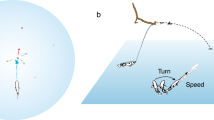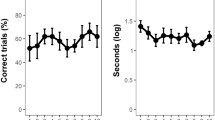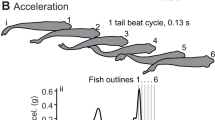Abstract
Predatory fish sometimes capture a prey fish first by striking it from the side, allowing the predator to consume the stunned prey head first. The rapid body flexion that the predator uses to stun its prey is similar to the “C” shaped maneuver (“C-bend”) that many fish species use when performing a C-start escape response. For most species, one of the two Mauthner neurons initiates the C-start and, together with other reticulospinal neurons, their activity determines the extent of the bend and the ultimate trajectory of the fish. Reported here is initial evidence of previously undescribed behaviors where goldfish strike an object while executing voluntary C-bends that are similar to their C-start escape responses. The overlapping distributions of turn durations, turn angles, and angular velocities suggest that at least some voluntary C-bends are initiated by the Mauthner neuron. This implies that the Mauthner neuron can be activated voluntarily in the absence of predator- or feeding-associated releasing stimuli.




Similar content being viewed by others
Abbreviations
- S.E.M.:
-
Standard error of the mean
References
Bosch TJ, Maslam S, Roberts BL (2001) Fos-like immunohistochemical identification of neurons active during the startle response of rainbow trout. J Comp Neurol 439:306–314
Canfield JG (2006) Functional evidence for visuospatial coding in the Mauthner neuron. Brain Behav Evol 67:188–202
Canfield JG, Mizumori SJY (2004) Methods for chronic neural recording in the telencephalon of freely behaving fish. J Neurosci Meth 133:127–134
Canfield JG, Rose GJ (1993) Activation of Mauthner neurons during prey capture. J Comp Physiol A 172:611–618
Canfield JG, Rose GJ (1996) Hierarchical sensory guidance of Mauthner-mediated escape responses in goldfish (Carassius auratus) and cichlids (Haplochromis burtoni). Brain Behav Evol 48:137–156
DiDomenico R, Nissanov J, Eaton RC (1988) Lateralization and adaptation of a continuously variable behavior following lesions of a reticulospinal command neuron. Brain Res 473:15–28
Domenici P, Blake RW (1991) The kinematics and performance of the escape response in the angelfish (Pterophyllum eimekei). J Exp Biol 156:187–206
Domenici P, Blake RW (1993) Escape trajectories in angelfish (Pterophyllum eimekei). J Exp Biol 177:253–272
Domenici P, Blake RW (1997) The kinematics and performance of fish fast-start swimming. J Exp Biol 200:1165–1178
Eaton RC, Bombardieri RA (1978) Behavioral functions of the Mauthner neuron. In: Faber DS, Korn H (eds) Neurobiology of the Mauthner cell. Raven Press, New York, pp 221–244
Eaton RC, DiDomenico R (1986) Role of the teleost escape response during development. Trans Am Fish Soc 115:128–142
Eaton RC, Emberley DS (1991) How stimulus direction determines the trajectory of the Mauthner-initiated escape response in a teleost fish. J Exp Biol 161:469–487
Eaton RC, Farley RD (1975) Mauthner neuron field potential in newly hatched larvae of the zebra fish. J Neurophysiol 38:502–512
Eaton RC, Hackett JT (1984) The role of the Mauthner cell in fast starts involving escape in teleost fishes. In: Eaton RC (ed) Neural mechanisms of startle behavior. Raven Press, New York, pp 213–226
Eaton RC, Nissanov J (1985) A review of Mauthner-initiated escape behavior and its possible role in hatching in the immature zebrafish, Branchydanio rerio. Environ Biol Fishes 12:265–279
Eaton RC, Bombardieri RA, Meyer DL (1977) The Mauthner-initiated startle response in teleost fish. J Exp Biol 66:65–81
Eaton RC, Lavender WA, Wieland CM (1981) Identification of Mauthner-initiated response patterns in goldfish: evidence from simultaneous cinematography and electrophysiology. J Comp Physiol 144:521–531
Eaton RC, Lavender WA, Wieland CM (1982) Alternative neural pathways initiate fast-start responses following lesions of the Mauthner neuron in goldfish. J Comp Physiol 145:485–496
Eaton RC, DiDomenico R, Nissanov J (1988) Flexible body dynamics of the goldfish C-start: implications for reticulospinal command mechanisms. J Neurosci 8:2758–2768
Eaton RC, DiDomenico R, Nissanov J (1991) Role of the Mauthner cell in sensorimotor integration by the brainstem escape network. Brain Behav Evol 37:272–285
Eaton RC, Lee RKK, Foreman MB (2001) The Mauthner cell and other identified neurons of the brainstem escape network of fish. Prog Neurobiol 63:467–485
Eaton RC, Nissanov J, Wieland CM (1984) Differential activation of Mauthner and non-Mauthner startle circuits in the zebrafish: Implications for functional substitution. J Comp Physiol A 155:813–820
Fernald RD (1975) Fast body turns in a cichlid fish. Nature 258:228–229
Fetcho JR (1991) Spinal network of the Mauthner cell. Brain Behav Evol 37:298–316
Fetcho JR (1992) Excitation of motoneurons by the Mauthner axon in goldfish: complexities in a “simple” reticulospinal pathway. J Neurophysiol 67:1574–1586
Foreman MB, Eaton RC (1993) The direction change concept for reticulospinal control of goldfish escape. J Neurosci 13:4101–4113
Gahtan E, Sankrithi N, Campos JB, O’Malley DM (2002) Evidence for a widespread brain stem escape network in zebrafish. J Neurophysiol 87:608–614
Harper DG, Blake RW (1991) Prey capture and the fast-start performance of northern pike Esox lucius. J Exp Biol 155:175–192
Liu KS, Fetcho JR (1999) Laser ablations reveal functional relationships of segmental hindbrain neurons in zebrafish. Neuron 23:325–335
Nakayama H, Oda Y (2004) Common sensory inputs and differential excitability of segmentally homologous reticulospinal neurons in the hindbrain. J Neurosci 24:3199–3209
New JG (2002) Multimodal integration in the feeding behaviors of predatory teleost fishes. Brain Behav Evol 59:177–189
New JG, Alborg Fewkes L, Khan AN (2001) Strike feeding behavior in the muskellunge, Esox masquinongy: contributions of the lateral line and visual sensory systems. J Exp Biol 204:1207–1221
Nissanov J, Eaton RC, DiDomenico R (1990) The motor output of the Mauthner cell, a reticulospinal command neuron. Brain Res 517:88–98
O’Malley DM, Kao Y-H, Fetcho JR (1996) Imaging the functional organization of zebrafish hindbrain segments during escape behaviors. Neuron 17:1145–1155
Poralla J, Neumeyer C (2006) Generalization and categorization of spectral colors in goldfish. Ll. Experiments with two and six training wavelengths. J Comp Physiol A 192:469–479
Porter HT, Motta PJ (2004) A comparison of strike and prey capture kinematics of three species of piscivorous fishes: Florida gar (Lepisosteus platyrhincus), redfin needlefish (Strongylura notata), and great barracuda (Sphyraena barracuda). Marine Biol 145:989–1000
Preuss T, Kleemann G, Osei-Bonsu PE, Faber DE (2002) C-start escapes evoked by visual stimuli in the goldfish. Soc Neurosci Abstr No. 87.11
Preuss T, Osei-Bonsu PE, Weiss SA, Wang C, Faber DS (2006) Neural representation of object approach in a decision-making motor circuit. J Neurosci 26:3454–3464
Schriefer JE, Hale ME (2004) Strikes and startles of northern pike (Esox lucius): A comparison of muscle activity and kinematics between S-start behaviors. J Exp Biol 207:535–544
Webb PW (1978) Fast-start performances and body form in seven species of teleost fish. J Exp Biol 74:211–226
Webb PW, Skadsen JM (1980) Strike tactics of Esox. Can J Zool 58:1462–1469
Weiss SA, Zottoli SJ, Faber DS, Preuss T (2004) Chronic medullary recordings from freely swimming fish during the C-start escape. Soc Neurosci Abstr No. 672.4
Weiss SA, Zottoli SJ, Do SC, Faber DS, Preuss T (2006) Correlation of C-start behaviors with neural activity recorded from the hindbrain in free-swimming goldfish (Carassius auratus). J Exp Biol 209:4788–4801
Wöhl S, Schuster S (2007) The predictive start of hunting archer fish: a flexible and precise motor pattern performed with the kinematics of an escape C-start. J Exp Biol 210:311–324
Zottoli SJ (1977) Correlation of the startle reflex and Mauthner cell auditory responses in unrestrained goldfish. J Exp Biol 66:243–254
Zottoli SJ (1978) Comparative morphology of the Mauthner cell in fish and amphibians. In: Faber DS, Korn H (eds) Neurobiology of the Mauthner cell. Raven Press, New York, pp 13–45
Zottoli SJ, Faber DS (2000) The Mauthner cell: what has it taught us? Neuroscientist 6:25–37
Zottoli SJ, Hordes AR, Faber DS (1987) Localization of optic tectal input to the ventral dendrite of the goldfish Mauthner cell. Brain Res 401:113–121
Zottoli SJ, Bentley AP, Prendergast BJ, Rieff HI (1995) Comparative studies on the Mauthner cell of teleost fish in relation to sensory input. Brain Behav Evol 46:151–164
Zottoli SJ, Davis GW, Northen SC (1992) Comparative studies of the Mauthner cell in teleosts. In: Benedetii I, Bertolini B, Capanna E (eds) Neurology today. Selected symposia and monographs, vol 7 Unione Zoologica Italiana, Mucchi Editore, Modena, Italy, pp 53–64
Zottoli SJ, Newman BC, Rieff HI, Winters DC (1999) Decrease in occurrence of fast startle responses after selective Mauthner cell ablation in goldfish (Carassius auratus). J Comp Physiol A 184:207–218
Acknowledgments
I am grateful to Drs. Sheri Mizumori and Joseph Sisneros for reading previous versions of this manuscript, to Aiko and Ryan Mizumori Canfield for assistance with data collection, and to two anonymous reviewers for their detailed critiques and suggestions. The procedures reported herein were approved by the University of Washington IACUC and comply with the “Principles of animal care”, publication No. 86-23, revised 1985, of the National Institutes of Health and with the current laws of the USA.
Author information
Authors and Affiliations
Corresponding author
Rights and permissions
About this article
Cite this article
Canfield, J.G. Some voluntary C-bends may be Mauthner neuron initiated. J Comp Physiol A 193, 1055–1064 (2007). https://doi.org/10.1007/s00359-007-0258-2
Received:
Revised:
Accepted:
Published:
Issue Date:
DOI: https://doi.org/10.1007/s00359-007-0258-2




